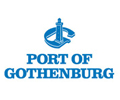
On Monday morning, shipping company CLdN’s newly built vessel made her first call at the Port of Gothenburg. Faustine is the company’s most advanced vessel and can be operated on liquefied natural gas or biogas. Now, she will be deploying the route between Zeebrugge and the Port of Gothenburg. Today, the ship will be loaded with Swedish export products and will reach Zeebrugge.
CLdN ordered Faustine as the first vessel to be equipped with an LNG, high pressure, dual-fuel propulsion systems that can use liquefied natural gases or biogas (LNG/LBG or diesel).
Faustine is one of the technologically advanced vessels we are investing in to reduce climate impacts. Emil Holmgren, Country Manager of CLdN, stated that she has the same cargo capacity as her H5 sister ships, but we can optimize the cargo mix more effectively due to technical improvements.
Faustine calls at at Gothenburg Roro Terminal in the Port of Gothenburg and is deployed on CLdN’s existing traffic between Gothenburg and Zeebrugge. It is a major destination for Swedish trade with Central Europe. Zeebrugge is a significant hub with a catchment area that covers the entire BeNeLux, Germany, and France. For further transport to other European countries, such as the United Kingdom, Spain, or Ireland, Swedish export goods can also be transhipped at Belgian port. Food, vehicles, steel, and forest products are all part of the cargo that is transported to and from Belgium.
The Port of Gothenburg currently hosts 12 departures per week to and from Belgium, which includes shipping companies DFDS/EML who operate via the ports of Ghent/Zeebrugge.

Faustine called the port of Gothenburg on Monday morning for the first time. The ship arrived in Zeebrugge on Tuesday with Swedish export goods. Photo: Gothenburg Port Authority.
The importance of Belgian traffic to Swedish foreign trade cannot be understated. Jacob Minnhagen, a business developer at the Gothenburg Port Authority, stated that CLdN continues its investment in a modern, efficient vessel with excellent environmental performance.
Faustine is an example of a recent LNG/LBG vessel that has been calling at the Port to a greater degree in recent years. This fuel is most popular in the tanker segment, where many shipping companies use Gothenburg to be their primary bunker hub for LNG or LBG.
The port has a long term strategy to make alternative fuels available to ships visiting the port. Methanol and LBG are two examples. The port is also conducting a feasibility study in collaboration with Statkraft, the Norwegian energy company. The goal is to begin in-port production hydrogen. Long-term, electric vessels will be delivered. Stena Line, with its Elektra vessels is the closest, will start calling the Port of Gothenburg and charging before 2030.
Fact sheet: M / V Faustine
Vessel type: Roro
2021, Year of construction
Length: 216.47m
Width 32.26 m
Capacity to load: 450 trailers or containers
Cargo decks: 5
Adjustable car decks: 2
Source: Port of Gothenburg

